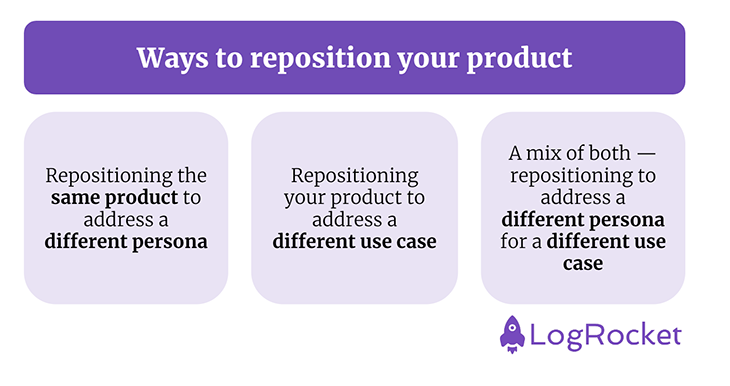You’re working on a product that isn’t a rocket ship. The business goals you set aren’t being met, people aren’t using your product, and despite your best efforts, you simply can’t drive more adoption or revenue. All your KPIs are flat. Your product is failing. What’s next?

It is a waste of time and resources to continue working on a product you know is failing. Once you identify that your product is failing, you must make changes as soon as possible. However, before you go crazy making massive changes, like shutting down the project and firing the entire team, it’s really important to get down to the root cause of why your product is failing.
Repositioning your product is when you shift the target market or use case you are going after. For example, if you’re a product analytics company, you could reposition yourself to go after marketing analytics.
The difference between repositioning and a pivot is that repositioning can often be accomplished without any significant, immediate product changes, whereas pivoting requires a complete switch across all company departments.
Repositioning is a powerful concept because it allows you to leverage faster, less expensive techniques to jumpstart growth. Making product changes is typically expensive and takes time, whereas changing your positioning, though equally challenging, can happen much faster.
There are typically two ways that you can think about repositioning. The first is repositioning the same product to address a different persona. The second is repositioning the same product to address a different use case. Perhaps you might consider doing both as well, but the inspiration for what you do should always come from customer feedback.
In the first case, when repositioning the same product to address a different persona, you’ll notice that the people you originally built your product for aren’t using your product, and instead, an unexpected persona is using your product heavily.
In the second case, you might hear consistent feedback that your solution is really interesting, but for a completely different use case. For example, maybe you built an internal tool to track support tickets within the company, but what people really want is an external tool that tracks support tickets.
In some cases, time is a remedy. It takes time to drive outcomes — marketing campaigns take time to kick in, sales outreach takes time to build pipeline, and product changes take time to pan out and execute.
That being said, let’s say you tried a bunch of different strategies, and you’ve discovered that you have a great product that simply doesn’t resonate with the current market you’re in. So it’s not that your product is broken and needs fixes or that your GTM strategies need a revamp, it’s that your product doesn’t fit the needs of the market you’re trying to go after.
These are the conditions when it’s worth considering repositioning as a way to turn your product around. If your product is failing for other reasons, you should address those other reasons rather than repositioning.
When you build a product, your primary goal is to achieve product market fit. Essentially, you want to build a product that addresses an important need for a target market. As you’re iterating your way to product-market fit, you’ll adjust your product, the way you talk about your product, how you market it, etc etc.
While you move forward in all these areas, you might discover new learnings about what customers really want from you. Often, when you first build a product, you’re close to the target on what to build, but you’re not 100 percent. Observing how your customers use and respond to your product is the secret to figuring out if you should reposition.
Once you’ve figured out how you want to reposition your product, it’s time to reposition it! Depending on how you want to reposition your product, your approach will obviously be different. Let’s go back to the cases we discussed before:

When thinking through how to reposition your existing product to address a different persona, the most immediate things to think about tend to be very go-to-market-focused.
Since you’re simply selling what you have to a different persona who appears to get more value out of it, you don’t need to make any immediate, significant product changes. Of course, as you start tackling this new persona, you may discover that your roadmap changes as that persona asks for different things. But usually, if you’re simply repositioning to a different persona, you don’t need to make any significant product changes in the near term.
So if no immediate changes need to be made to the product, how do you go about repositioning the same product to address a different persona?
I like to think about this process in terms of the typical steps a customer takes to adopt your product. When you reposition the same product to address a different persona, you’re largely changing the early steps a customer takes with you.
For example, a customer needs to first discover that you exist, understand what you do, decide on whether or not you’re a fit, enter a sales (or trial) cycle, and then finally adopt your product and become a full-time customer. Everything up until the customer adopts your product in areas where you need to make changes.
First, you have to understand how customers discover you, and this is different depending on which persona you’re going after. Developers might get all their news from HackerNews or Reddit, whereas marketers and salespeople tend to spend all their time on LinkedIn. Changing the channels on which you find your customers is critical to repositioning your existing product to a different persona.
Second, you have to think through how you communicate your value proposition to customers. This is often referred to as language-market fit. When a customer discovers you via a channel and either interacts with your website or a sales rep, are you speaking their language? Does what you say resonate? And do they understand what you do and how you can help them? The language you use to describe your product and your value props needs to change significantly if you want to go after a different persona.
And finally, when a customer decides they want to try out your product, either in a sales or self-serve trial capacity, they need to be able to see how your product provides value. Now this might seem contradictory to my earlier comment that you don’t need to make any significant product changes, so let me further clarify this. Early on as you seek to reposition, the fastest thing that you can do to adjust your product to match this new persona is to get the language-market fit right and use that same language throughout the product.
Of course, as you continue tackling this new market, you’ll want to make changes in onboarding, user experience, and functionality, but those can all come later. As long as customers can find or discover you and understand what you do, you’ll be able to make inroads in repositioning your product.
Repositioning becomes an entirely different story when you reposition for a different use case. Now, of course, you’ll want to think through how customers discover you and how you communicate your value proposition as in the first case. These are still critical and absolutely required, but when repositioning your product to address a different use case, you’ll likely need to rethink what features actually drive value, and this will ultimately result in changes to the product.
Let’s go through a small case study. Going back to the example of ticketing software, let’s say that you started out building ticketing software for internal use cases but kept hearing that what people really wanted and were willing to pay for was ticketing software for external use cases.
When you were going after building ticketing software for internal use cases, the most important feature that customers cared about was project management — assigning tickets to the right person to handle them. But you kept hearing feedback that people wanted to use your ticketing system for external issues and that they really liked a side feature of yours — tracking time to resolution.
With these learnings in mind, you will of course choose to change your positioning so that you talk more about tracking time to resolution. But, you might also consider making time to resolution more front-and-center in your product. Perhaps you build a dashboard, perhaps you delete more internally focused features, or perhaps you expand the functionality in your dashboards. You can see how a different use case can result in needing to change your feature set and your focus areas.
In some cases, you might discover that you have to go after a different persona for a different use case. If you take this further and simply change your entire product, this is really more like a pivot, but on the less extreme end, you can consider this a case of repositioning your product. In this case, you’ll want to combine the tactical things to do for both case 1 and case 2 into an overall strategy to completely revamp how you deliver and talk about your product.
We discussed how tactically, you’ll want to change what distribution channels you focus on, what language you use, and what features you prioritize, but perhaps most crucially, it’s important to spend more time than you think you need talking to customers. This is because the only way you’ll truly understand what the market wants is by identifying patterns across customers. If multiple customers (who are similar to each other) identify the same things that they care about, this is where you should double down.
Typically, when thinking about repositioning a product, I’ll write up a couple of hypotheses that I want to validate. Then, I’ll formulate the questions I want to ask someone to validate those hypotheses. After that, I’ll make sure to talk to at least 20 people who have the same profile. By doing so, you force yourself to go through the task of truly validating your assumptions before you spend time and resources on repositioning your product.
Ultimately, repositioning a product is a big endeavor that requires every team to make tough choices about what to keep and what to change. That’s why it’s important to first identify whether or not repositioning is necessary (or if more time or a pivot is in order). Next, you’ll want to figure out what kind of repositioning you need to make. And finally, never forget to validate with customers so that you can reposition in the right direction.
Featured image source: IconScout
LogRocket identifies friction points in the user experience so you can make informed decisions about product and design changes that must happen to hit your goals.
With LogRocket, you can understand the scope of the issues affecting your product and prioritize the changes that need to be made. LogRocket simplifies workflows by allowing Engineering, Product, UX, and Design teams to work from the same data as you, eliminating any confusion about what needs to be done.
Get your teams on the same page — try LogRocket today.

This article explains the most important fintech terms that you should be aware of to better navigate this field.

Anne Baskakova talks about her journey breaking into tech and her goal of inspiring other women to reach their full potential.

This article serves as a comprehensive guide to healthcare product managers, including roles, responsibilities, skills, and qualifications.

Priya Raghunatha shares her perspective on digital strategy and the two lenses it encompasses: data-driven and perception-driven.